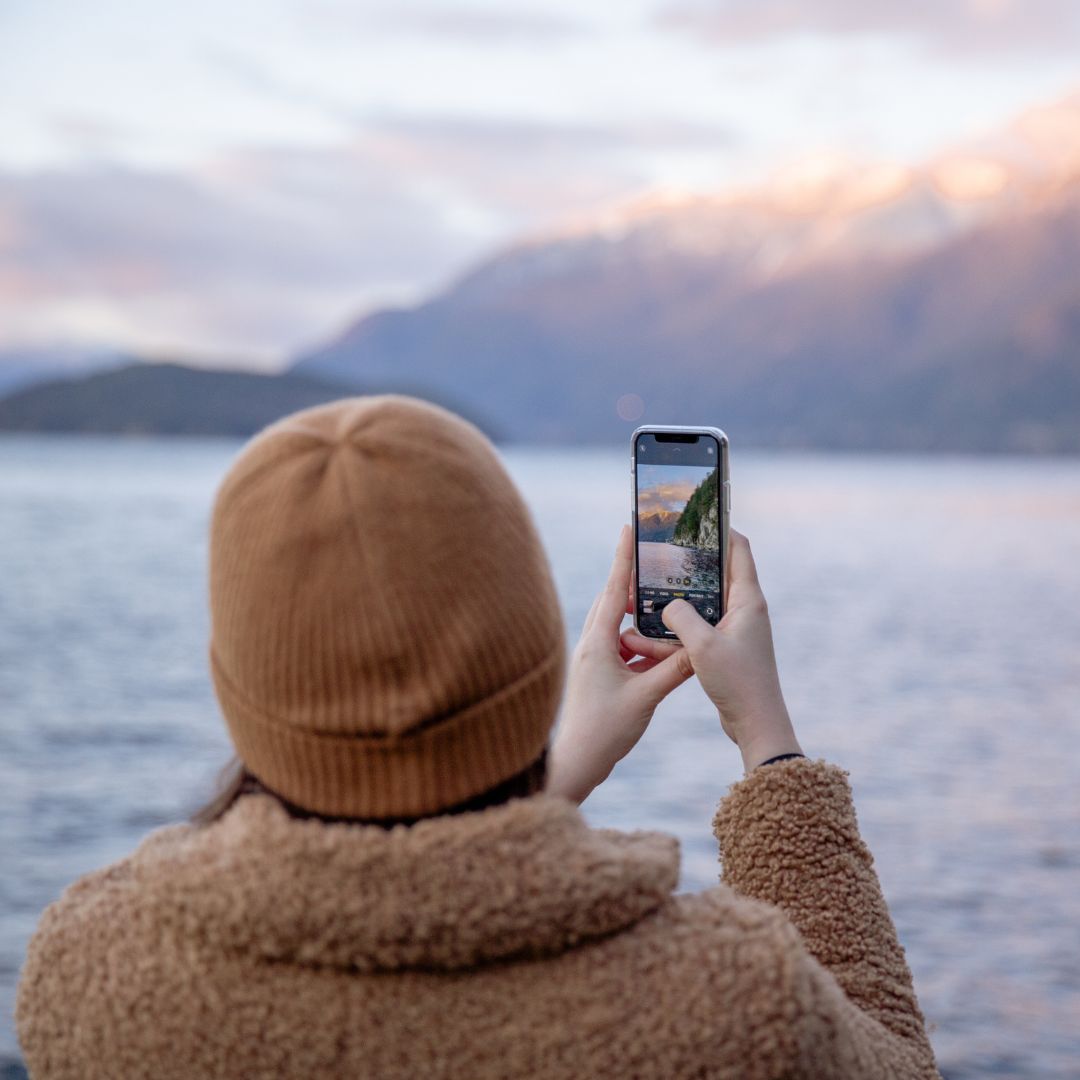Often, travel brands stumble into these five common social media marketing mistakes, which can shake their foundation completely. What’s worse, you might not even realise your brand is making them.
Get ready to sidestep these silent killers, ready to sabotage your success on social media. Arm your travel brand with the foresight to prevent these mistakes. Remember, in this digital battlefield, victory favours the vigilant.
Unveiling the 5 Silent Killers: Social Media Marketing Mistakes
- Understand what an ineffective social media strategy looks like
- Learn from real-life examples and case studies
- Discover the importance of user-generated content, consistent branding, and social media engagement
Travel businesses know that social media is a potent tool for reaching out to their audience. It is a double-edged sword, though. Success can quickly turn into failure if not handled with caution. Here are the five social media marketing mistakes that silently kill travel brands’ success.
Mistake 1: Ineffective Social Media Strategy
An ineffective social media strategy can leave your brand directionless, leading to wasted resources and opportunities. Creating content without understanding your target audience, keeping up to date with emerging technologies and trends or not having clear, measurable goals are all signs of a poor social media strategy.
Take Thomas Cook, for example. Initially, it lacked a precise online marketing strategy, which arguably contributed to its financial troubles. Thomas Cook boasted a remarkable 178-year legacy in the travel industry, pioneering package tourism and establishing an enduring market presence. Unfortunately, the brand could not change with the times as quickly as it should have. The travel brand struggled to navigate the internet era despite the efforts to modernise. Essentially, Thomas Cook failed to effectively pivot its business model to align with contemporary market dynamics and evolving customer demands. They missed out on the power of online bookings and a targeted online presence. This classic example should serve as cautionary instruction for anyone stepping into the choppy waters of social media marketing.
These days, people go to TikTok to start their holiday search instead of Google – and the landscape is ever-evolving. Consumers’ go-to platforms regularly change, consumer preferences and demands change, and it’s up to your travel brand to keep up with the trends. It’s all about adaptation – understanding your audience, knowing where they are and how to target them.
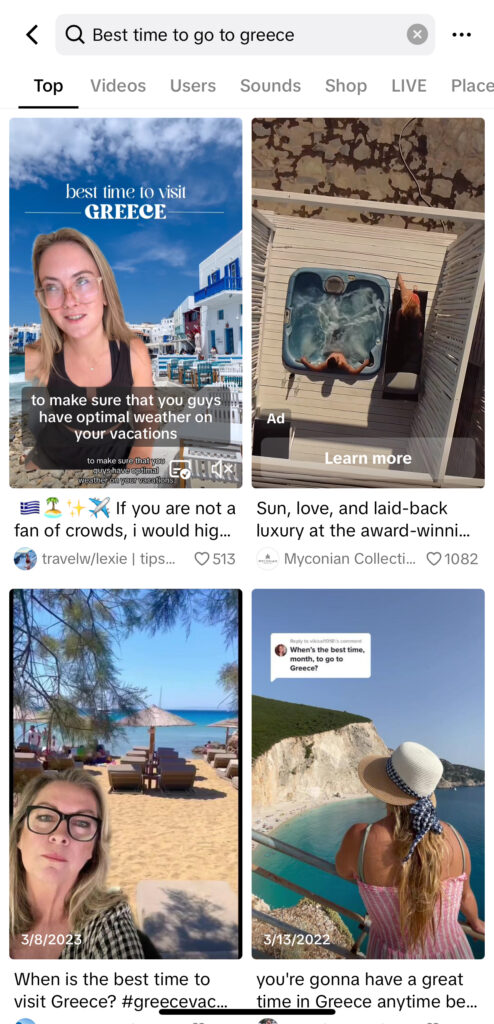
Mistake 2: Ignoring User-Generated Content
In the travel industry, people trust people. User-generated content (UGC) is the digital version of word-of-mouth marketing. There’s nothing like a personal anecdote to transport a person via imagination. Ignoring UGC is, unfortunately, a common mistake.
UGC, such as customer reviews, photos, and testimonials, offer social proof—word-of-mouth in the digital age. According to a study by TurnTo (now known as Emplifi), over 90% of consumers report UGC influences their purchase decisions.
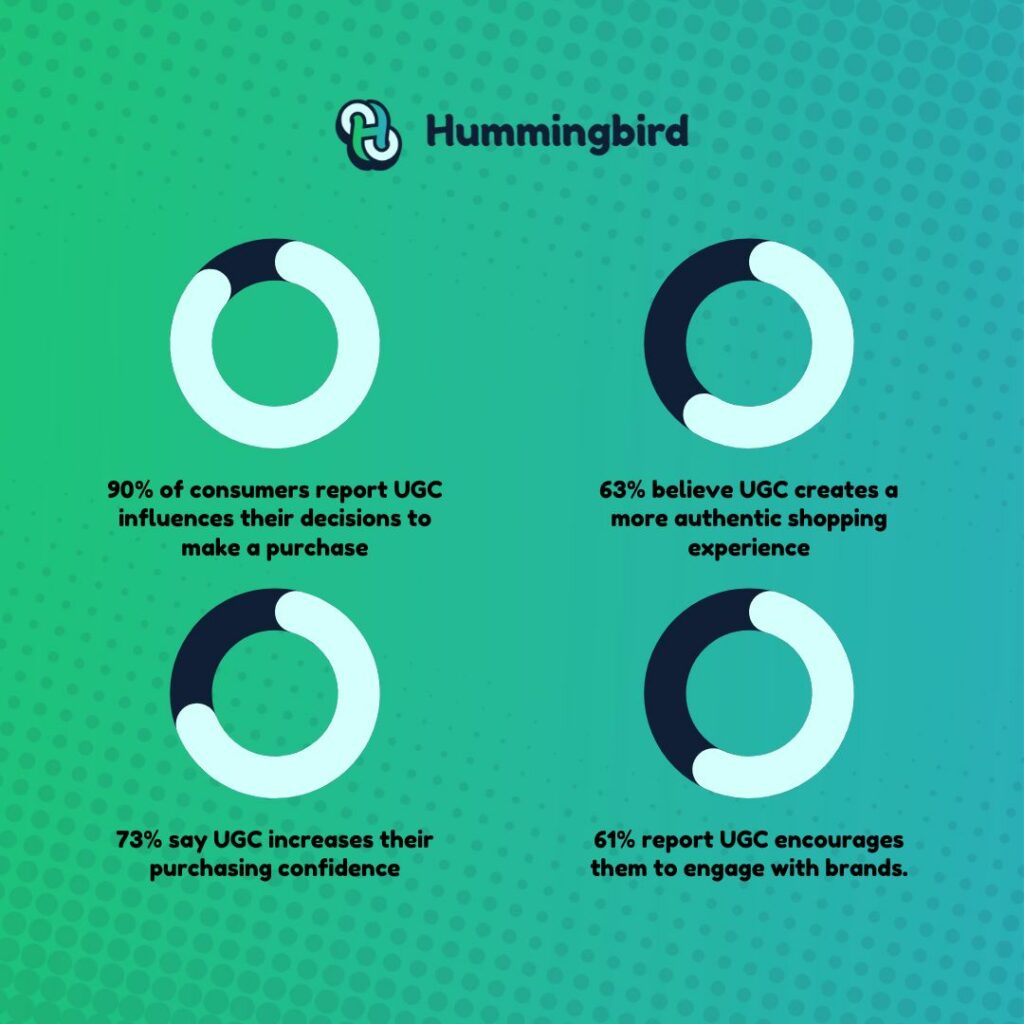
When travel brands dismiss UGC, they miss out on a goldmine of trust-building materials.
Mistake 3: Neglecting Influencer Marketing
Influencer marketing can work wonders when done right, especially in the travel industry. The missed boat comes when brands fail to leverage influencers effectively. It’s beyond just getting a famous face. The influencer’s values, target audience, and credibility also play key roles.
Remember when the Fyre Festival attempted to leverage influencer marketing to sell the dream island experience? The fallout from the ill-executed event was disastrous due to empty promises and the influencers’ failure to disclose paid promotions.
Mistake 4: Inconsistent Branding on Social Media
Imagine hearing a catchy tune only to be interrupted by an off-key singer—it’s jarring, right? Similarly, inconsistent branding on social media can be jarring to your audience. If you use different tones, messages, or visuals across platforms, your audience may be confused, and ultimately, you could lose their trust.
Just as travellers expect a smooth travel experience from start to finish, your audience anticipates a unified brand presence across various social media channels.
Imagine a traveller researching a dream destination and stumbling upon your Instagram page, filled with vibrant imagery and adventurous captions, getting consumers excited for that impending holiday. They click through to your TikTok account, expecting a continuation of that immersive experience, only to find a different tone and disjointed messaging. It’s like arriving at a new destination only to find it doesn’t match the brochure – confusing and disorienting.
Consistency in branding across social media platforms is crucial for travel brands. It builds trust, reinforces brand identity, and creates a sense of reliability among your audience. Whether it’s the same colour palette, consistent messaging style, or a unified tone of voice, maintaining coherence across platforms ensures that every interaction contributes to a cohesive narrative of your brand’s travel experience.
Mistake 5: Lack of Social Media Engagement
Think of a conversation. One party keeps talking while the other listens—that’s no dialogue, right? A similar aspect applies to social media. Brands often make the mistake of talking *at* their audience instead of engaging *with* them.
How to Avoid These Social Media Marketing Mistakes
- Crafting an effective social media strategy reduces the likelihood of costly missteps.
- User-generated content can significantly increase engagement and reach.
- Consistent branding and the use of influencers can strengthen your brand identity and reach in the travel market.
Crafting an Effective Social Media Strategy
A robust social media strategy is the backbone of successful online marketing. Travel brands must consider unique aspects like audience behaviours, travel trends, and cultural dynamics. The first step is identifying your audience. Are they luxury travellers, adventure seekers, or budget backpackers? Knowing your audience helps create targeted content that resonates.
The second step involves setting clear objectives. These could range from increasing website traffic, boosting direct bookings or driving brand recognition. Remember, it’s not about chasing every new trend. It’s about leveraging what works best for your brand.
The third step is creating content that benefits your audience. Share practical travel tips, exciting destination facts, or customer experiences—the aim is to build brand trust and customer loyalty, not just sell your services.
Leveraging User-Generated Content
User-generated content (UGC) is a powerful tool for travel brands. It provides authenticity that resonates with audiences. Encouraging customers to share their travel experiences and tag your brand increases your exposure and credibility.
Jet2’s @jet2pics Instagram account is an excellent example of this. They often share UGC photos from customers’ travel experiences.
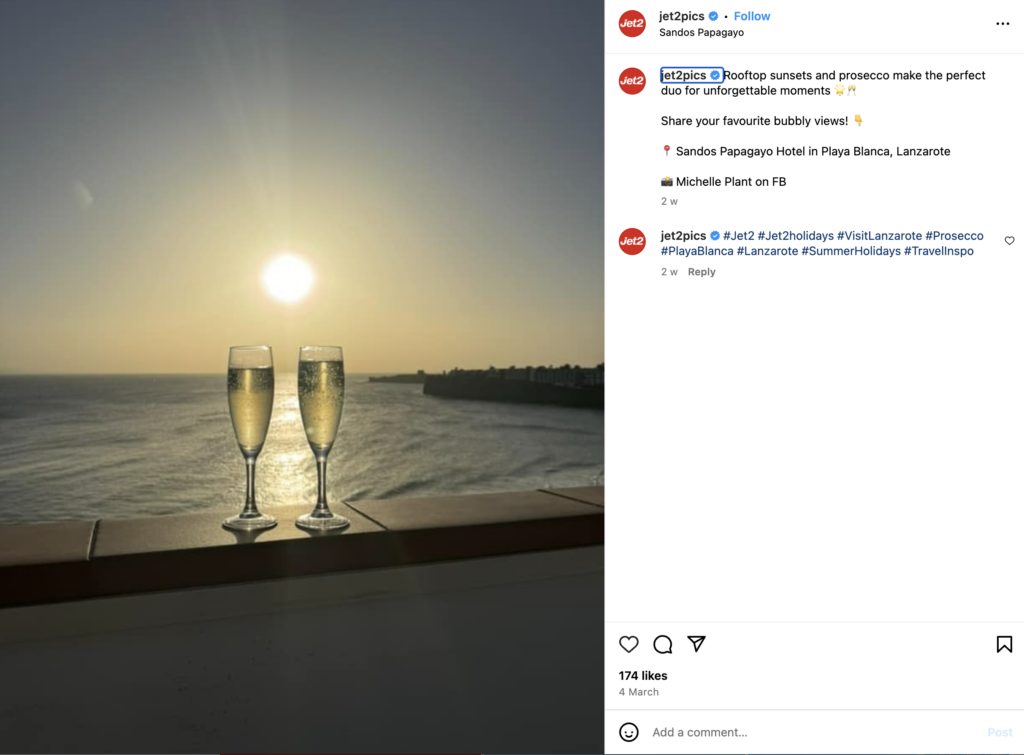
Consider creating an easy, brand-specific hashtag that customers can use. Highlight user posts on your page to create a sense of community and incentivise further sharing.
UGC isn’t only about social media posts; it can also extend to reviews and testimonials. Good reviews boost your brand’s reputation while pointing out areas for improvement. Remember to engage with UGC, thank customers for positive reviews, and address any concerns raised.
Harnessing the Power of Influencer Marketing
Collaborating with influencers can dramatically increase your brand’s reach and reputation. The trick is to partner with influencers whose niche aligns with your brand. Their endorsement provides credibility, and their unique content style can help your brand reach a wider audience.
Airbnb, for example, often collaborates with influencers and celebrities in its social media campaigns. It has even partnered with Lady Gaga.
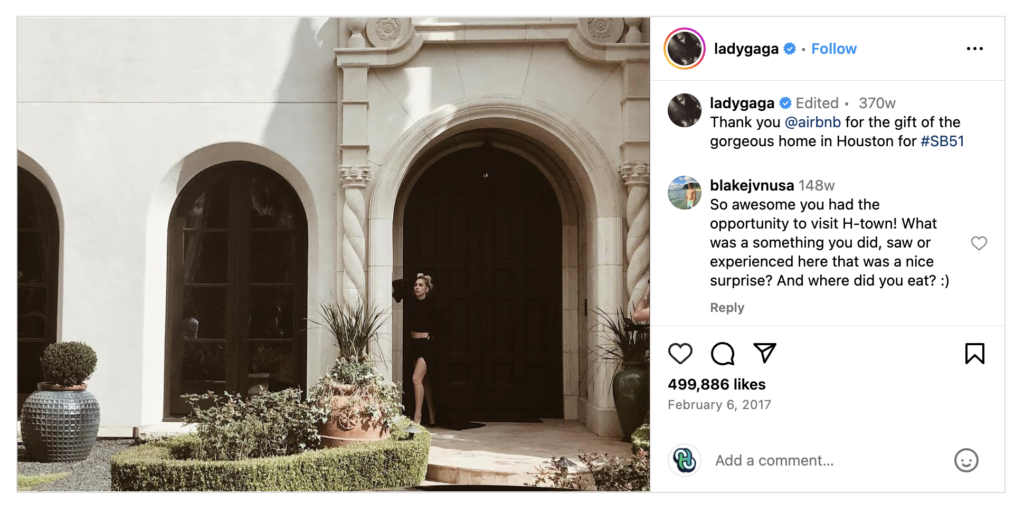
Having an explicit agreement on deliverables and expectations benefits both parties. Consider co-creating content with influencers to maximise engagement. Remember to share this content across all your platforms for extensive reach.
Maintaining Consistent Branding Across Platforms
Consistency fortifies your brand image, giving your content an easily recognisable signature style. Your brand’s tone, visuals, and overall message should be consistent across all platforms. This includes the colour palette, fonts, and style of photography used.
TUI, for example, maintains its branding across its social media platforms. The messaging is consistent, and the brand logo and colours are the same, fostering brand trust and boosting brand recognition.
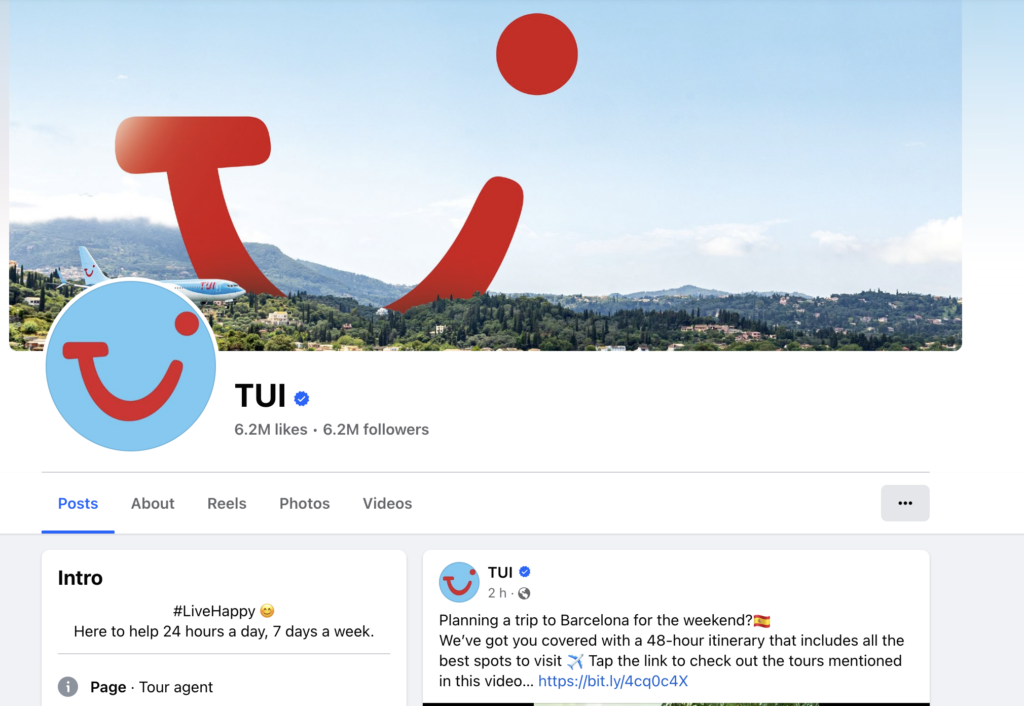
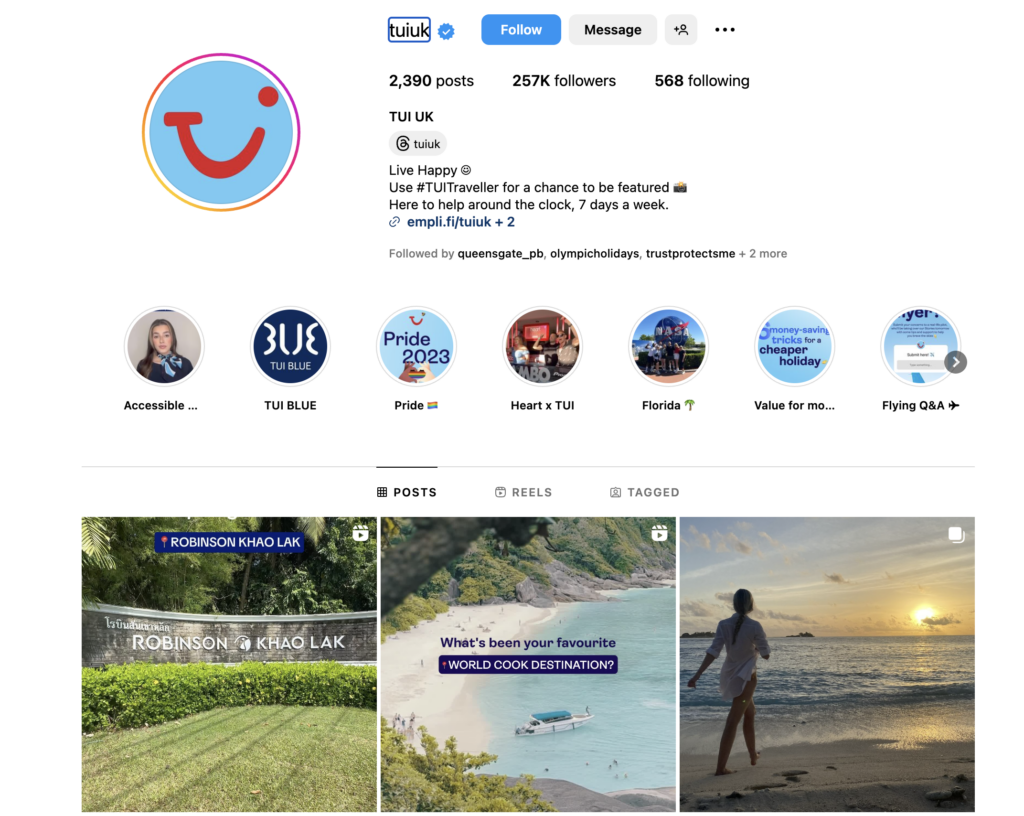
Keep in mind that consistency doesn’t mean monotony. Vary the type of posts to keep your audience engaged—from blog post shares, inspiring travel images, informational videos, and quizzes, for example.
Boosting Social Media Engagement
Engagement is more than likes and shares; it’s about creating conversations and building relationships. Some useful techniques include asking questions in your posts, creating polls, and responding promptly to comments and messages.
Remarketing is another effective strategy. Presenting users who have interacted with your brand with tailored content improves conversion rates.
Don’t hesitate to lighten the mood with humour. Travel is about fun, and your social media should mirror this joy. Skyscanner often responds to comments on its social media channels, making them appear approachable, friendly, and trustworthy by keeping up with ongoing conversations. It’s almost like talking to your friends.
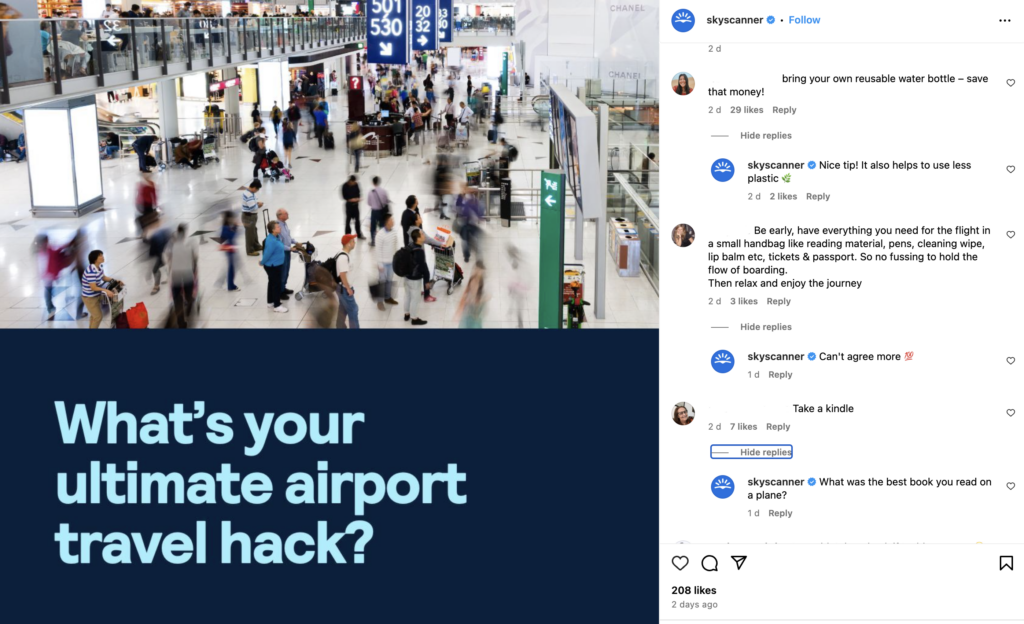
Understanding the Importance of Social Media Marketing for Travel Brands
- The travel industry heavily depends on social media.
- Social media significantly boosts travel brand visibility.
- Using social media strategically, travel brands can engage and build strong relationships with their consumers.
- Social media offers promising avenues for market research within the travel industry.
The Role of Social Media in the Travel Industry
Social media is a potent tool for influencing travel decisions. The inspirational photos, customer reviews, and location-specific tips found on these platforms steer holidaymakers and business travellers alike. They offer an invaluable source of information for people who wish to explore a new destination or revisit a favourite one. They provide insights into the must-visit places, best foods to try, or hidden gems in a city or country, all of which shape ultimate travel choices.
Making Travel Plans
With its appealing visual content and location tags, social media platforms like Instagram and TikTok significantly influence travel plans. Similarly, platforms like X and Facebook offer real-time updates about specific destinations, aiding travel planning.
The Impact of Social Media on Brand Visibility
Social media platforms can serve as a branding megaphone for travel brands. A frequent, consistent presence on platforms where potential consumers hang out can increase brand visibility immensely. Sharing high-quality, engaging content that resonates with the audience can attract more followers, leading to higher engagement and potential conversion rates.
Organic Campaigns and Sponsored Ads
Through strategic organic campaigns and sponsored ads tailored to the interests of a specific audience, travel brands can improve their online visibility and reach a wider demographic.
The Power of Social Media in Customer Engagement
Efficient use of social media can enable travel brands to create an interactive relationship with their customers. By posting quizzes, polls, or invitations for user-generated content, brands can engage their followers while gaining insights into their preferences and travel behaviours. The comments or direct messages section on social media platforms also fosters direct dialogue between the company and its customers.
Creating a Community
By employing the right social media marketing tactics, travel brands can create an online community of followers who will actively engage with the brand and even serve as brand promoters.
The Potential of Social Media for Market Research
Social media platforms can also be a practical way for travel brands to collect consumer insights. By analysing users’ trends, behaviour, and sentiments, brands can better understand their consumers, tailor their services accordingly, and forecast future demands.
The Influence of Social Media on Brand Reputation
Social media can significantly influence the reputation of travel brands. Critical reviews or negative news can spread quickly and widely on social platforms, potentially harming a brand’s reputation. Conversely, positive reviews and brand mentions can uplift public perception.
Responding to Reviews
To protect and improve their reputation, brands can use social media platforms to respond promptly and professionally to customer reviews or complaints, showing a commitment to customer satisfaction.
Booking.com is a great example of responding to comments promptly and professionally.
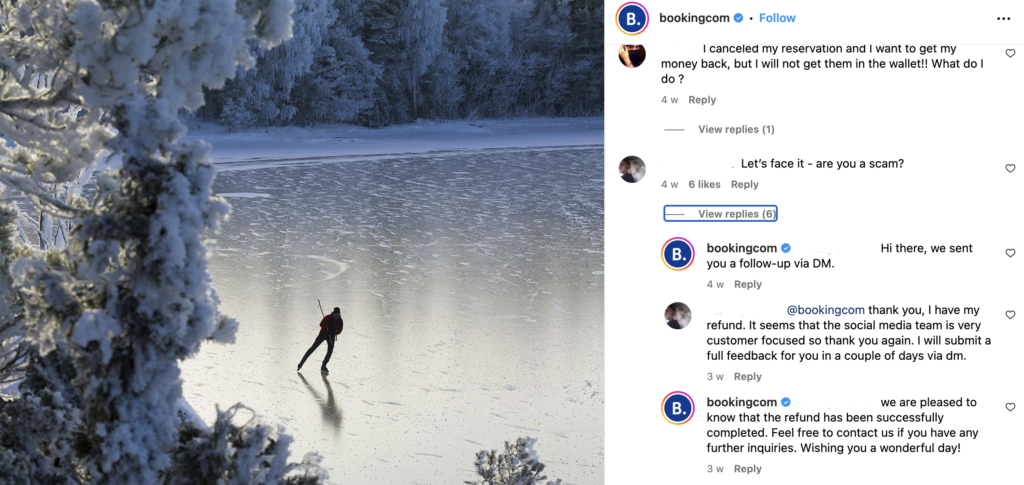
Conclusion
Travel brands often make the five social media marketing mistakes mentioned in this blog: ineffective strategy, ignored user-generated content, neglected influencer partnerships, inconsistent branding, and a lack of engagement.
To succeed, travel brands must craft a focused strategy, leveraging user-generated content and influencer collaborations to build authenticity and reach. Consistent branding across platforms reinforces trust, while active engagement fosters genuine connections with the audience.
In summary, by avoiding these pitfalls and embracing strategic, engaging, and authentic storytelling, travel brands can thrive and be successful on social media.
Have you thought about hiring an agency to take on your social media accounts? Take a look at the travel marketing services we provide to lessen your workload.

